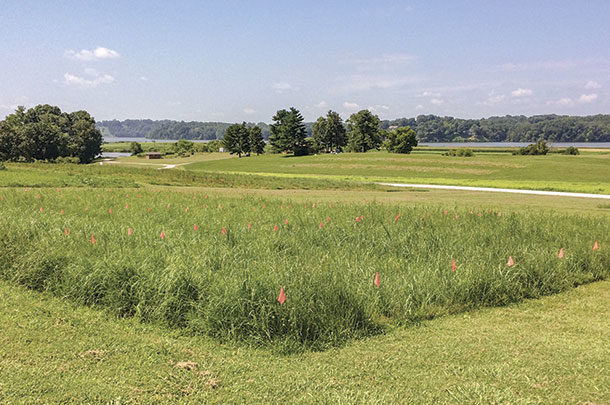However, these grasses should be managed with the same care and consideration as any other forage crop. Identifying and applying the optimum amount of fertilizer for hay production is a basic and essential step in grass management. We wanted to explore these relationships further and develop recommendations for producers.
Several native warm-season grass studies have been conducted in the Midwest, but there is a lack of fertility response data in native warm-season forage production systems in the humid East, where we have very different soils and climate.
Due to this lack of data, we evaluated fertility responses of two commonly used native forage grasses, big bluestem and switchgrass, for the eastern U.S.
To be clear, several studies have been conducted in the eastern U.S. looking at fertility responses of native grasses, but those have focused almost exclusively on switchgrass then, in a single-harvest biomass production setting. In these biomass scenarios, harvests occur only after dormancy, which allows nutrients to have returned to the root system prior to harvest and, as a result, they are not removed from the plant.
In contrast, growing-season harvests add additional stress to plants, requiring them to regrow leaves, stems and perhaps even growing points – all of which require additional energy (and nutrients), much of which are drawn from root reserves. Therefore, in a hay production setting, nutrient requirements are expected to be greater than for biomass production.
Hay yields
In 2014, we began a study (see photo above) to look at each primary nutrient – nitrogen (N), phosphorus (P) and potassium (K) – and compare hay yields for big bluestem and lowland switchgrass. Nutrients and application rates are listed in Table 1.

We are also evaluating the impact of these grasses and treatments on soil health parameters (soil carbon, cation exchange capacity, etc.) over the course of the study. Fertilizers were applied in a split application (late April and in June following the first harvest) each year.
All plots were harvested to an 8-inch stubble height twice each year, either early June and early August or early June and following fall dormancy. Soil cores were taken from zero to 6 inches and 12 to 18 inches in 2017 and will be taken again at the end of the study as part of our evaluation of soil health.
As expected, our data shows applying N (Figure 1) influenced and increased yield more than P (Figure 2) or K (Figure 3).

Big bluestem yields were greatest at 180 units N, while those for switchgrass were greatest at 240 units. At 120 units of N, big bluestem yields leveled off and then, at 240 units, decreased.

For switchgrass, yields decreased above 60 units until spiking again with 240 units, a pattern we cannot explain at this time. Regardless of N rate, both species produced more tonnage with N amendments than when not fertilized at all.

Keep in mind, though: By producing the most hay, you may not be using the most economical amount of fertilizer. For instance, above 120 units N, big bluestem yields would not offset the increased cost of additional fertilizer.
The same holds true for N with switchgrass where any increased yield above 60 units N would not be worth increased cost. Also, it is worth remembering, applying more than 60 units at a time could put grazing cattle at risk for nitrate toxicity.
Grazing
Your livestock feeding requirements should also determine your fertilizer needs. If you can achieve satisfactory forage production by using lower levels of N, there is no need to pay for the additional fertilizer.
For example, big bluestem production at 60 versus 30 units N did not affect yield enough (an increase of only 0.1 ton per acre) to warrant the extra 30 units. On the other hand, switchgrass yields increased by nearly 1.2 tons per acre from 30 to 60 units N per acre, making the increase more worthwhile.
For our study, using P and K fertilizers produced negligible increases in yield. Phosphorus yields did not differ among application rates. At our location, soils were not P-deficient. In other situations where soils have lower background P levels, response could be greater.
Yields increased when applying any amount of K fertilizer to switchgrass. However, any rate greater than 75 units produced lower tonnage than that of 75 units. Our results show applying K, even in small amounts, could improve profitability.
However, applying more than 75 units would be a waste of money (in our situation) since yields were actually reduced with the additional K. Due to space limitations, we did not evaluate K for big bluestem.
Based on these preliminary results, N application at 60 units for switchgrass and no more than 120 units for big bluestem, appear to be optimal. In the case of big bluestem, where higher yields are not critical, 30 units may be a good choice.
Although P and K did not provide substantial increases in yield, we recommend yearly soil tests and maintenance of nutrient levels at “medium” for P and K. This is good, basic stewardship and will ensure appropriate levels of essential nutrients are available for proper plant growth and maintenance of stand vigor.
It is also important to recognize: Under grazing scenarios, nutrient demands are likely to be lower than in our study using hay harvesting and removed considerable nutrients from the stand. ![]()
PHOTO: Big bluestem and lowland switchgrass can produce good, quality summer forage when harvested at proper maturity and with appropriate fertility management. Photo provided by Patrick Keyser.
Jonathan D. Richwine is a graduate research assistant with the Center for Native Grasslands Management, University of Tennessee – Knoxville.

-
Patrick Keyser
- Professor
- Director of the Center for Native Grasslands Management
- University of Tennessee Institute of Agriculture
- Email Patrick Keyser







